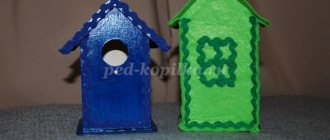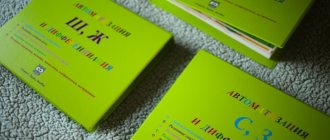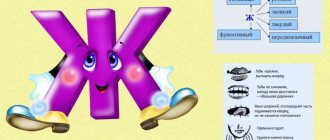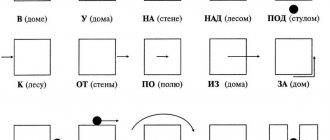Types and causes of violations of the pronunciation of the sound Ш
The distortion of sibilants is called sigmatism. In the case of the sound Ш, various options are possible:
- interdental - the tip of the tongue occupies a position between the upper and lower teeth, which gives a lisp;
- lateral - the tongue lies on its edge and a stream of air flows along its lateral edge. The result is a squelching sound;
- nasal - occurs due to the contact of the back with the soft palate, which, when lowered, opens a passage into the nasal cavity for an air stream;
- labiodental - the original sound is replaced by another unvoiced sound F. For example, cap - “fapka”.
Factors leading to articulation problems:
- physiological: short sublingual frenulum or high palate, malocclusion, tension or weakness of the lingual muscles;
- problems with phonemic and speech hearing, as well as insufficient development of memory, attention, and thinking;
- long-term use of the pacifier. This spoils the bite and leads to distortion of hissing sounds;
- repetition of incorrect pronunciation. For example, a child distorts his speech following adults or younger brothers/sisters.
You can diagnose the problem yourself, but it is better to contact a speech therapist in time.
Staging from other sounds
The method is suitable for children with normal pronunciation of other phonemes from which Sh can be put:
- Through S. We pronounce a long “s-s-s” or stretch out “s-a-a-a”, fix the resulting position of the tongue. While pronouncing, use a spatula or finger to lift the tip of your tongue higher and hold it behind your upper teeth so that it touches the alveoli. Ask the student to exhale while maintaining the tongue position and see how “sa” changes to “sha”;
- Through T. Slowly pronouncing the phoneme with the addition of an aspiration “t-t-t”. We gradually learn to lengthen the air stream and not touch the tubercles on the palate with the tongue;
- Through R. A rare method due to the fact that this phoneme is usually even more difficult for children than sibilants. We keep our mouth open and say a silent R. We stop the vibration with the handle of a teaspoon, resulting in a hissing sound. Each time we use the spoon less and less, thus teaching the child to keep his teeth together and pronounce Sh automatically.
Always start with articulatory gymnastics - the tongue must be prepared for complex work. Warm up - at least 5 minutes. The total duration of classes should not exceed 25 minutes, otherwise children quickly lose interest.
Articulation of the sound Ш
Correct pronunciation is possible if certain conditions are met. The lips take a “horn” position - slightly rounded and pushed forward. There is a space of about 1 mm between the upper and lower teeth. A wide tongue takes the shape of a “cup” (the sides are pressed against the teeth, and the tip is located behind the upper teeth, leaving a gap between the tongue and the palate).
If everything is correct, then the stream of exhaled air goes in the middle, they are wide and warm. The vocal cords are open, and a dull consonant sound is produced.
It is necessary to regularly perform staging exercises with a speech therapist or at home to achieve the desired result.
Articulation gymnastics
It is important to carry out the performance in stages - first it is important to create sufficient strength and duration of the output. Speech therapists practice various articulation activities to relax the tongue and practice lifting it. You need to go from simple to complex, increasing the load.
At the first stage of setting the sound Ш, easy but important tasks are given to prepare the muscles of the tongue: make the lips a tube, open the mouth wide for a few seconds, lick the upper lip with a wide, cup-shaped tongue, move the tongue across the palate, from the teeth to the throat.
More complex common exercises for setting Sh:
- "Wide tongue" Ask the child to smile and slightly open his mouth, show his relaxed tongue like a pancake, and then place his tongue on his lower lip. Ideally, you should hold the position for up to 5 seconds;
- “Hide the candy.” Let your baby make a “pancake” of his tongue on his lower lip. Give him a piece of marshmallow or marshmallow and ask him to hide the treat by gluing it to the roof of his mouth behind his upper teeth. The mouth should not open too wide, and the exercise should be done at a slow pace;
- "Fungus". Ask your young student to smile widely and show his teeth, then press his entire tongue to the roof of his mouth. While holding the position, you need to try to open your mouth as wide as possible. It is optimal to perform the task in front of a mirror - the child will see the resemblance of the tongue and frenulum to a mushroom;
- "Groove". This task is important because it teaches you how to form a tubercle on the tongue, which is necessary for setting the Sh. First, your student shows a wide tongue, placing it “pancake-like” on the lower lip and slightly opening his mouth. Then he presses the edge of the tongue in the same position to the side corners of the mouth, the tongue itself narrows a little - the same “groove” is formed;
- "Cup". The tip and lateral edges of the tongue are raised and held in this position. To enhance the effect, a speech therapist or parent can pour a little water into the “cup”.
To avoid difficulties in positioning the Sh during classes, make sure that the child does not rest his entire tongue on the palate.
Consolidating pronunciation
The speech therapist not only plays the sound, but also automates it. For preschoolers, lessons are structured in an interesting playful way. Approximate plan for stage-by-stage production of Ш:
- We look for the letter in the picture and learn a poem about it.
- We pronounce the syllables sha, sho, shu, after mastering them - ash, ush, osh.
- We consolidate open and closed syllables in conjunction with other phonemes: what, staff, jester.
- We train the pronunciation of words with Ш in the middle and at the end.
- We pronounce short and then more complex sentences with Sh.
We gradually complicate the tasks, fully introducing Sh into free speech. If difficulties arise in the performance, you should not move on to the next stage - it is important to hone your skills consistently. Work everything to perfection - there is no hurry.
Diagnostics
It is important to assess how well all components of speech are formed. If there are deviations, speech therapists pay special attention to the appearance of the lips, the tone of the tongue, the state of the bite, the work of facial and articulatory muscles, and the force of exhalation. Standard diagnostic exercises in speech therapy:
- Please show emotions: joy, surprise, sadness.;
- Stretching the lips with a tube and fixing them in a certain position;
- Movements of the jaw in different directions, attempts to relax the tongue, make it wide/narrow;
- Blowing away a light object, playing the pipe;
- Pronunciation of phonemes separately, as well as in words and phrases;
- Compose a story from the given words and pictures.
Based on the results of the examination, suitable exercises are selected for performance. You can use the classic options, widely used in speech therapy.
![Visual and didactic manual on sound automation [C] “Interesting cards”](https://lubcentre.ru/wp-content/uploads/naglyadno-didakticheskoe-posobie-po-avtomatizacii-zvuka-s-interesnye-kartochki-330x140.jpg)







